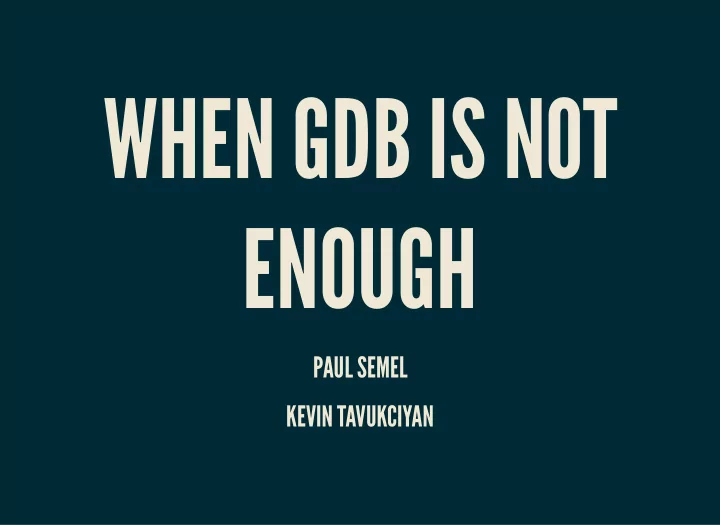

WHEN GDB IS NOT ENOUGH PAUL SEMEL KEVIN TAVUKCIYAN
TALKING ABOUT DWARF
TALKING ABOUT DWARF DEBUGGING WITH ATTRIBUTE RECORD FORMATS
WHAT IS DWARF?
WHAT IS DWARF? Format used to store debug informations Generated by the compiler Sections in the binary format
HOW DOES IT WORK?
INFO Contains all information on our types Informations are sorted by compilation units. Info entry are called DIE (Dwarf Info Entry).
COMPILATION UNIT Interesting projects have more than one source code �le and are compiled separately and linked together They are called Compilation Unit in DWARF Each DIE are different and separated by compile units
DIE (SOUNDS APPEALING ALREADY HUH?) Basic description entry in DWARF Has a tag which precises what it describes Can describe data or functions/executable code
ABBREV Table of abbreviation Used to compress data inside the section Contains info on the content of the DIE
APPLICATIONS
GNU BINUTILS Multiple DWARF4 parsing implementation Too deeply merged in the rest of the projects 10k+ LOC in objdump / 25k+ LOC in gdb
OUR PROJECT
DWARF PRETTYPRINTER Get structure members. Print structure content. 1500 LOC : Deal with it Stallman !
WHAT WAS THE POINT OF THE PROJECT? Create a lib that can print the structure when given a pointer to it. Useful for debug when gdb is too much. As fast and as lightweight as possible.
TECHNIQUES USED
DWARF FORMAT PARSING DWARF format is against us. We needed a technique to avoid loading the whole DWARF tree in memory
WHAT'S WRONG WITH THIS ? We need to parse the whole format until we �nd a DIE. The size of a tag can be variable.
SO, HOW CAN WE OPTIMIZE THIS ? We need to �x the size of as most tag as we can. If we encounter a structure, we keep it in memory. We remain where we stopped parsing the last time.
VISITOR
WHAT DO WE NEED ? Give depth traversing control to the user. The user must be able to hook everywhere. By default depth traversing and printing functions.
HOW CAN WE DO THAT ? Each node has a default depth traversing function. We store printing functions in a hash table. Basic types must have a default printing function. The traversing is triggered by the printing function.
NODE STRUCTURE struct Die { const char *name; const char *type; void *data; size_t len; struct list children; struct list sibling; void (*next)(struct Die *, struct hash_control *); }; This is the structure given to the user
LET'S TRY IT !
THE TEST STRUCURE typedef uint16_t u16; struct example { unsigned short int a; u16 b; };
void *init_dwarf(char *path); int print_structure_content(void *address, char *name, void *di, void* ctx); /* * param 1 : ctx may be NULL the first time the function is called * param 2 : name may be NULL if no type specification * param 3 : musn't be NULL * param 4 : print function * * param 1 : Current Die * * param 2 : User data * * param 3 : Must be sent to next() function if called * param 5 : user data */ void *set_context(void *ctx, const char *name, const char *type, void (*print)(Die *, void *, void *), void *data)
void print_uint16(Die *die, void *data, void *h) { printf("%s %s : %d\n", die->type, die->name, *(unsigned short int *)die->data); } int main(void) { struct example t; t.a = 1234; t.b = 42; void *te = init_dwarf("/proc/self/exe"); void *ctx = NULL; ctx = set_context(NULL, NULL, "uint16_t", print_uint16, NULL); print_structure_content(&t, "example", te, ctx); }
BY DEFAULT struct example : t short unsigned int b : 42 short unsigned int a : 1234 WITH OUR HOOK struct example : t uint16_t b : 42 short unsigned int a : 1234
What's next? Recursive parsing Parse faster when given a compile unit.
CONCLUSION
QUESTIONS?
Recommend
More recommend